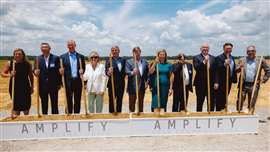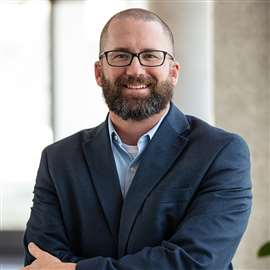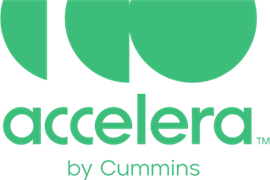Accelera’s Wilson on new JV, the future of BE commercial vehicles in North America
25 August 2024
Accelera by Cummins, a business segment of Cummins focused on zero-emission power technologies, recently completed its joint venture with Daimler and Paccar announced in September 2023. Called Amplify Cell Technologies, it’s an enterprise intended to localize battery cell production and the battery supply chain in the United States.
The JV recently broke ground on a two million sq. ft. (185,806 m2) facility in Marshall County, Miss., that will have an annual manufacturing capacity of 21 gigawatt hours (GWh).
Brian Wilson, general manager of Accelera’s eMobility business, said these developments are significant for industry adoption of battery electric (BE) solutions in North America.
 Local, state and federal officials in Mississippi at the groundbreaking for a battery-cell construction project for Amplify Cell Technologies JV. (Photo: Accelera by Cummins)
Local, state and federal officials in Mississippi at the groundbreaking for a battery-cell construction project for Amplify Cell Technologies JV. (Photo: Accelera by Cummins)
“We’ve aligned on what the right, winning technology is going to be for commercial vehicles in North America,” he said. “We put a flag in the ground and said this is what’s going to win. Let’s scale around this future and this vision.
“That not only means what’s being produced there at the factory and not only means what’s going to get produced in the vehicles. It also means the investments that need to come from the supply base of Amplify Cell Technologies.”
Wilson said that Amplify’s suppliers will likely recognize the market strength of the JV members, making it easier for them to make investments supportive of the JV’s approach to decarbonizing commercial vehicles.
“I think the credibility of Paccar, Daimler and Accelera by Cummins coming together to say we’re launching with 21 GWh in 2027, this allowed the supply chain to say, OK, this thing — it’s with real companies that have real demand that are going to be here 100 years down the road,” he said. “So, we can put our dollars behind localizing the supply chain for this technology now because of the companies that are involved.”
Cummins also recently announced a $75 million U.S. Dept. of Energy (DOE) grant — one the company will match — that will result in converting manufacturing space at its Columbus Engine Plant (CEP) in Indiana to expand manufacturing for Accelera. This includes battery packs, powertrain systems and other battery-electric vehicle (BEV) components.
“We think one of the critical pieces that needs to happen in this up-ramp of electrification and anything e-mobility is really the partnership with the government and states,” Wilson said. He added that such partnerships will foster the investment in developing and manufacturing electric components as well as allowing for the scale necessary to bring costs down for marketplace adoption.
“That $75 million from [the government] is going to pair with the $75 million investment here in what we call Plant 1 in Columbus, Ind.,” he said, adding that it could be argued Plant 1 has been “the capital of diesel engine manufacturing in the United States.”
“We’re going to build these batteries right here in Columbus, Ind., where we built our diesel engines,” Wilson said.
Regarding potential applications for Accelera technology, Wilson said that BE is not ideal for everything, and that hydrogen fuel cells or hydrogen internal combustion (IC) engines will be more effective in some cases.
“Both school buses and to some extent transit buses are really great applications for battery electric solutions,” he said. One reason is that they end up in the same place every night.
“As you start to think about infrastructure challenges and planning for how you’re going to make sure that these batteries have the state of charge that you need them to have to operate their mission, having them come back to the same place every time is helpful for that,” Wilson said.
Another reason why BE solutions work for buses is their operational usage.
 Brian Wilson, general manager of Accelera’s eMobility business. (Photo: Accelera by Cummins)
Brian Wilson, general manager of Accelera’s eMobility business. (Photo: Accelera by Cummins)
“If you’re going to drive 1,500 miles every single day, that’s going to be a difficult use case,” he said. However, driving perhaps 100 miles per day or less, such as the distance traveled by a bus, is more appropriate to a BE solution.
“They don’t travel very far; they come back to the same place every single night,” Wilson said. “It’s a perfect use case for putting a minimal amount of batteries on the school bus and being able to charge it to the state of charge that you want every single night to fulfill its mission. And transit buses, [it’s] really the same way.”
According to Wilson, last-mile delivery is another good application, but it has some infrastructure challenges. “That’s a little more complicated with last-mile delivery,” he said. However, he said Class 4 - 6 vehicles might also be good candidates for electrification.
“If you think about pickup and delivery — a little bit larger than the last-mile stuff — I think those applications here within the next few years that are really going to start to move,” he said. “You’re going to start seeing more fleets start to trial those and figure out how to use them in their system effectively and efficiently
Refuse vehicles have appropriate duty cycles for BE applications, but they also have unique challenges.
“It’s similar to the transit bus in the fact that it’s coming and going to the same place every single night, but the weight varies quite greatly from when the day starts and in the middle of the day and when the day ends,” Wilson said. “So, you have to be able to plan for the capacity and the power out of your batteries to be able handle that changing weight distribution throughout the day. So, it’s a bit more tricky to solve.”






